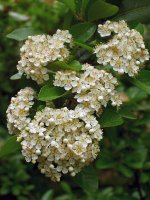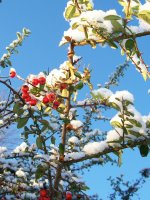More About Trees and Plants...
 These beautiful clusters of blossoms are the spring glory of the pyracantha.
These beautiful clusters of blossoms are the spring glory of the pyracantha.We have a row of these shrubs planted on the north side of the house. I had read that they were a good plant for the north side, but in hindsight, I think a sunnier location would be better for them. Had I realized that they would lean out and try to reach the sunshine horizontally as well as vertically, I would not have planted them where they are.
These shrubs are 11 or 12 years old and they are about 8-10 feet tall. Each of these clusters of blossoms is about the size of a golf ball. The bushes are not densely branched. They are more like a small tree than a bush. They have stout branches, not just a tangle of little twigs.
On their branches, they have long sharp thorns, and the biggest ones are two inches or so in length. Many of the twigs are really just thorns with leaves because they have a sharp tip. The thorny branches can inflict serious damage, so I have severely pruned the shrubs several times to keep them out of my way when I'm mowing. I apply the rules of tree pruning to them because of their tree-like structure.
Pyracantha is a member of the rose family, so these sharp protectors are to be expected. Its common name is firethorn.
 Pyracantha is an attractive shrub in the fall and winter when the blossoms become red berries. The berries stay on the branches a long time; this photo was taken in February this year.
Pyracantha is an attractive shrub in the fall and winter when the blossoms become red berries. The berries stay on the branches a long time; this photo was taken in February this year.The first year that these shrubs had a handful of berries, Isaac (who was about 6 years old) picked them! He didn't realize I wanted them to stay on the branch to look pretty.
I have seen birds eat the berries, but not often. They must not be very tasty or they would disappear much more quickly than they do. I think more berries shrivel up and drop to the ground than the birds eat. One of the articles I linked to above mentions that birds often fly eratically after eating pyracantha berries. Maybe the pulp of the berry ferments a little inside its skin after it's been through several freezes and thaws.
I was surprised to find recipes for jelly made from pyracantha berries, as I was looking for some links to add to this article. If you decide to save or make this recipe, please don't just cover the hot jelly with melted paraffin as the recipe suggests. Seal the jars properly with 2-piece canning lids, and process them in a hot water bath for at least 5 minutes.
Technorati tags: pyracantha firethorn
No comments:
Post a Comment